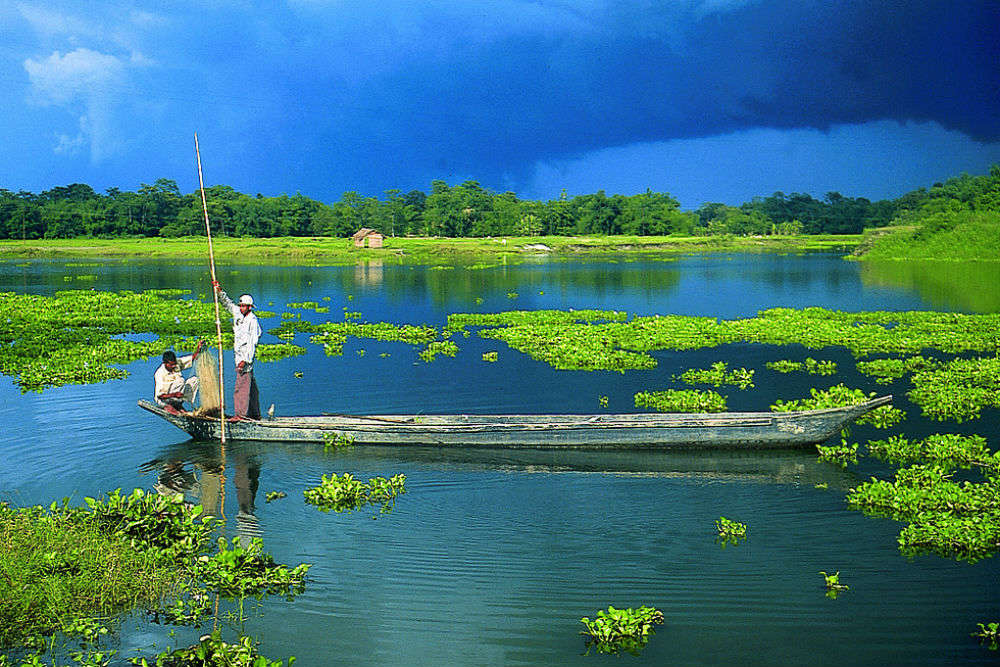MAJULI MASKS
- Handcrafted masks have a traditional use in portraying characters in bhaonas, which are theatrical performances conveying devotional messages within the neo-Vaishnavite tradition.
- This tradition was introduced by the 15th-16th century reformer saint Srimanta Sankardeva. These masks, crafted from materials like bamboo, clay, dung, cloth, cotton, and wood found in the riverine surroundings of the creators, represent various entities such as gods, goddesses, demons, animals, and birds.
- The range of masks varies from smaller ones covering just the face (mukh mukha), requiring approximately five days for completion, to larger ones enveloping the entire head and body of the performer (cho mukha), which may take up to one-and-a-half months to craft.
- Notable characters depicted in these masks include Ravana, Garuda, Narasimha, Hanuman, Varaha, and Surpanakha

It is a form of painting — also originating in the 16th century — done on sanchi pat, or manuscripts made of the bark of the sanchi or agar tree, using homemade ink.
The earliest example of an illustrated manuscript is said to be a rendering of the Adya Dasama of the Bhagwat Purana in Assamese by Srimanta Sankardev. This art was patronised by the Ahom kings. It continues to be practised in every sattra in Majuli
5. GI tag and Majuli Island
A GI tag is conferred upon products originating from a specific geographical region, signifying unique characteristics and qualities. Essentially, it serves as a trademark in the international market.
Majuli, the largest river island in the world and the seat of Assam’s neo-Vaishnavite tradition, has been home to the art of mask-making since the 16th century. Today, many of its traditional practitioners are working to take the art out of their traditional place in sattras, or monasteries, and give them a new, contemporary life
6. Majuli Island
Majuli is a river island situated in the Brahmaputra River in the northeastern state of Assam, India. It is recognized as the world's largest river island and covers an area that is subject to change due to the dynamic nature of the Brahmaputra River. Majuli is known for its scenic beauty, rich cultural heritage, and unique way of life.
Here are some key aspects of Majuli Island:
-
Geography: Majuli is formed by the Brahmaputra River in the south and the Kherkutia Xuti, an anabranch of the Brahmaputra, in the north. The island faces the threat of erosion due to the powerful river, leading to a reduction in its land area over the years.
-
Cultural Significance: Majuli is a hub of Assamese culture and Vaishnavite philosophy. The island is home to numerous Sattras, which are monastic institutions associated with the Neo-Vaishnavite tradition founded by the saint and cultural icon, Srimanta Sankardev. The Sattras are centers of religious and cultural activities, including traditional music, dance, and theater.
-
Biodiversity: The island is ecologically diverse and hosts a variety of flora and fauna. The wetlands, water bodies, and marshes on Majuli are home to numerous bird species, making it an important area for birdwatching.
-
Satras: Majuli is known for its Satras, which were established by Srimanta Sankardev and his disciples. These monastic institutions play a significant role in preserving and promoting Assamese culture through various art forms like Borgeet (devotional songs), Satriya dance, and Bhaona (religious plays).
-
Erosion Challenges: One of the critical issues faced by Majuli is riverbank erosion. The island has been shrinking over the years due to the constant erosion caused by the Brahmaputra River, making it vulnerable to environmental changes

|
Previous Year Questions
1.Majuli, the largest riverine Island is found in which of the following rivers? (SSC GD 2019) (RRB NTPC CBT 2 2022)
A.Narmada
B.Kaveri
C.Brahmaputra
D.Godavari
Answer (C)
|




